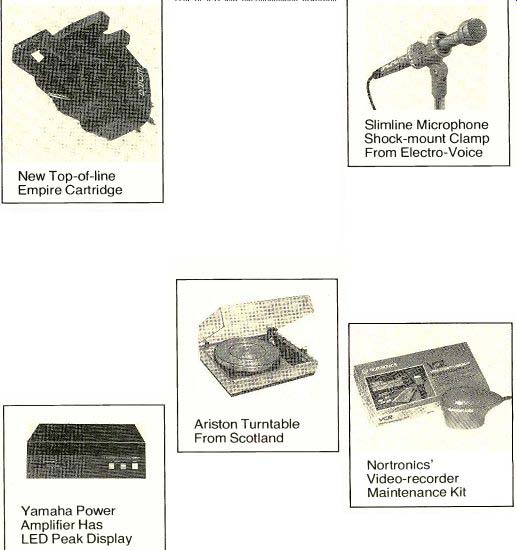
New Top-of-line Empire Cartridge
The Empire EDR.9 phono cartridge is a moving-ir6n design using a "large area con tact" stylus-tip shape similar to that of a Shibata stylus in that it provides a long, low-pres sure region of contact between the stylus and the groove. The EDR.9 also incorporates a small metal bar resiliently mounted inside the hollow aluminum cantilever tube; this is said to reduce resonance so as to equalize the response of the cartridge. Empire states that the new cartridge is minimally affected by variations in load impedance. Frequency response of the EDR.9 is 20 to 35,000 Hz ±1.75 dB.
Tracking-force range is 3/4 to 1 1/4 grams, compliance is 28 micro-dynes per centimeter, out put is 4.5 millivolts for a 5-centimeter-per-second lateral velocity, and total cartridge weight is 5.2 grams. Price: $200.
Yamaha Power Amplifier Has LED Peak Display
The Yamaha M-4 power amplifier has a dual array of twenty-six LED's to display the peak power-output level; there is also a LED overload indicator that lights up when distortion in the amplifier's output exceeds 1 percent. The M-4 is rated at 120 watts per channel into 8-ohm loads from 20 to 20,000 Hz, with total harmonic distortion of 0.005 percent or less and intermodulation distortion less than 0.002 percent. The signal-to-noise ratio is rated at 118 dB using IHF A weighting. Frequency response at 60 watts output into 8 ohms is specified as extending from 0 Hz to 100 kHz +0,-1.2 dB in the direct-coupled mode and from 10 Hz to 100 kHz +0,-2 dB in the a.c.-coupled-mode. The low-frequency filter, which is switched into the signal path in the a.c. mode, attenuates the signal at the rate of 6 dB per octave below 6.4 Hz.
Yamaha states that the output circuit of the M-4 is of the fully complementary push-pull type and uses newly developed power-output transistors designed especially for this unit.
The M-4 also includes a load-impedance detecting circuit that cuts the power off when the impedance at the output falls below 2 ohms and a d.c.-detection circuit that disconnects the loudspeakers if direct current appears at the outputs. Front-panel controls include the power switch and pushbutton selector switches for two pairs of speakers; rear-panel controls include two input-level knobs and the a.c./d.c. selector switch. Dimensions are 17 1/2 x 5 3/4 x 14 3/4 inches. The enclosure finish is matte black, and weight is 41 pounds. Price: $650.
The Scotland-made Ariston RD11S is a two-speed, belt-drive turntable designed to be used with a separate tone arm (it is shown fitted with an Ultracraft tonearm and Osawa head shell and cartridge). It has an exception ally heavy (9.5-pound) platter of an aluminum-zinc alloy and a twenty-four-pole synchronous motor. The main bearing is a mirror-finish steel shaft that rotates in a self-lubricating Teflon sleeve. The tonearm board, motor, and platter are mounted on a subchassis that is in turn suspended from shock absorbers.
Wow and flutter is rated at less than 0.05 percent, and the weighted rumble specification is -80 dB. The RD11S comes with a teak base and hinged dust cover. Dimensions are 17 1/2 x 14 x 6 inches. Price: $600. For more information, write to Osawa & Co., Dept. SR, 521 Fifth Avenue, New York, N.Y. 10017.
Slimline Microphone Shock-mount Clamp From Electro-Voice
Electro-Voice's new Model 313A shock-mount clamp is designed for unobtrusively mounting microphones having barrel diameters of about 3/4 inch on any standard 5/8-inch-thread microphone stand. In use, the clamp suspends the microphone in a network of four replaceable urethane bands. The microphone body can be attached either with an integral hinged-metal latch for a quick temporary mount or with a set-screw assembly for long er-term applications. The 313A is constructed of polycarbonate plastic and metal. Price: $22.95.
Nortronics' Video-recorder Maintenance Kit
Nortronics Company of Minneapolis, a major manufacturer of tape heads and sup plies, has introduced the VCR-95, a maintenance kit for videocassette recorders. The kit contains twenty cellular-foam cleaning swabs, a spray cleaner specifically developed for head-cleaning applications, a special screwdriver, a dust cloth, and instructions for cleaning both VHS and Beta-format recorders. Price: $12.80.
-----------------
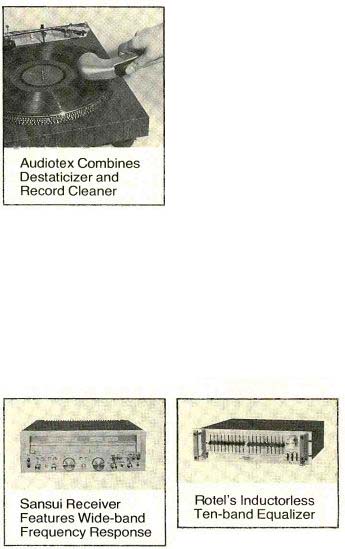
Audiotex Combines Destaticizer and Record Cleaner
Audiotex, a division of GC Laboratories, has introduced the RC-2000 record-cleaning device, which combines the functions of a destaticizing tool and a record brush. The RC-2000 contains a piezoelectric cell that emits alternate streams of positive and negative ions as the device's trigger is pressed and then released. The ions are discharged directly onto the record surface through a tube and needle outlet on the underside of the handheld device.
On the underside of the RC-2000 are sever al rows of fine nylon bristles and a natural-silk velvet pad; these act together to dislodge and then pick up dust that previously had been statically bound to the record surface. Price: $24.95.
Sansui Receiver Features Wide-band Frequency Response
The power-amplifier section of Sansui's G-7500 AM/FM stereo receiver has a rated frequency response of 0 to 200,000 Hz (-3 dB) and a slew rate of 60 volts per microsecond. Sansui states that the wide frequency response and absence of blocking capacitors in the signal path of the amplifier stages have significant benefits in terms of transient response. The G-7500 is rated at 90 watts per channel into 8-ohm loads from 20 to 20,000 Hz with total harmonic distortion of 0.025 percent or less. Intermodulation distortion is also rated at 0.025 percent or less.
The preamplifier section of this receiver has a signal-to-noise ratio of 78 dB (measured using current IHF methods) and RIAA-curve accuracy to within 0.2 dB of ideal. The maximum undistorted input capability of the pho no preamplifier stage is 240 millivolts. The unit has bass and treble controls that afford ±10 dB of adjustment at nominal 50-and 10,000-Hz turnover points, infrasonic and high filters that attenuate at the rate of 6 dB per octave below 16 Hz and above 3,000 Hz, respectively, and an audio-muting switch that attenuates the output by 20 dB. The loudness-compensation circuit boosts output by a maximum of 8 dB at 50 Hz and 6 dB at 10,000 Hz.
The FM tuner of the G-7500 has a usable sensitivity of 1.8 microvolts (10.3 dBf), sensitivity for 50-dB quieting in stereo of 34.7 microvolts (36 dBf), and a signal-to-noise ratio (for a 65-dBf input) of 58 dB in stereo. Total harmonic distortion of the FM section for the same 65-dBf input level is 0.18 percent at 1,000 Hz in stereo. Capture ratio is 1 dB, al ternate-channel selectivity is 75 dB, and stereo separation is 42 dB at 1,000 Hz. Front panel features of the unit include dual power-output meters and dual tuning meters, a microphone mixing jack and level control, switching for two pairs of speakers, switchable FM de-emphasis, a tone-control defeat switch, and two tape-monitor pushbutton switches. The G-7500 has a simulated-rose wood-grain enclosure, and its dimensions are approximately 20 x 7 1/2 x 16 1/2 inches. Price: $620.
Rotel's Inductorless Ten-band Equalizer
The Rotel RE-2000 is a ten-band stereo equalizer that offers a ±-12-dB range of adjustment at ten frequencies spaced approximately one octave apart: 32, 63, 125, 250, 500, 1,000, 2,000, 4,000, 8,000, and 16,000 Hz. The RE-2000's controls are of the linear sliding type, and separate sets of controls permit individual adjustment for each channel. The equalizer circuits use transistors and passive components in a design configuration Rotel calls an "Inductorless Active-Resonant Circuit," an approach said to eliminate the electromagnetic induction of hum and noise sometimes associated with models that use inductors. The RE-2000 has front-panel switches that control two tape-monitor circuits with dubbing facilities, a bypass switch to compare the sound of an equalized vs. an unequalized program, and an output-level control. Total harmonic distortion is rated as below 0.005 percent, signal-to-noise ratio is 100 dB or greater (measured through the IHF A network), and frequency response extends from 0 to 100,000 Hz-1 dB. The RE-2000 is rack-mountable and comes with rack handles. Dimensions are approximately 19 x 5 1/2 x 13 3/8 inches. Price: $370.
---------------------
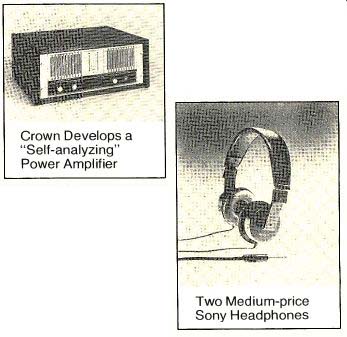
Crown Develops a "Self-analyzing" Power Amplifier
As part of its Distinction Series of components, Crown has introduced the SA2, a 220-watt-per-channel power amplifier that uses a "self-analyzing" protection circuit to avoid the sonically deleterious side effects said to be characteristic of some conventional protection circuits. The SA2's protection system is an analog circuit that examines the operating conditions of the output transistors and limits the power output of the amplifier only when their margins of safety will be exceeded rather than limiting power output at some predetermined voltage or current level. As a result, the SA2 is said to be capable of very high power outputs over a brief period; for example, Crown states that the SA2 has an instantaneous output capability of 900 watts per channel into a 4-ohm load and 1,500 watts per channel into a 2-ohm load (the input in both cases being a pink-noise signal). Other interesting features of the SA2's design include two separate power supplies (one for each channel), a heat-sink configuration that em ploys a two-speed cooling fan to move air past an array of exceptionally thin (and therefore thermally efficient) heat-sink fins, and power transformers that are shock-mounted to minimize chassis vibration.
The front panel of the SA2 amplifier has two multi-LED output-level indicators that display a range of 42 dB; the indicators both display instantaneous peaks and hold the highest peak-signal level. The two uppermost LED's are illuminated when significant distortion appears at the output of the amplifier (they are part of an input-output comparator circuit of the same type as that used on a number of other Crown products). Other front-panel controls include the two input-level knobs, the power switch, and an amber stand by light that glows when the amplifier is first turned on or when the power supplies disconnect from the remaining circuits in response to overheating or the appearance of direct current at the outputs.
The SA2's specifications include frequency response of 0 to 50,000 Hz-±-1dB in the direct-coupled mode, total harmonic distortion of 0.05 percent or less, intermodulation distortion of 0.01 percent or less, and a signal-to noise ratio of 115 dB (A-weighted) below rat ed output. The slewing rate of the amplifier is 30 volts per microsecond or more, and mono output with the two channels combined is 700 watts into 8 ohms measured at a distortion level of 0.12 percent. Dimensions are 19 x 14 3/4 x 7 inches. Price: $1,595.
Two Medium-price Sony Headphones
Sony has introduced two medium-price headphones, one a sealed-earcup type, the DR-2, and the other a folding pocket-size unit, the DR-6M (shown). The DR-2 is equipped with two 70-millimeter cone-type driver units. Frequency response is specified as 20 to 20,000 Hz, sensitivity is 104 dB for a 1-milliwatt input, nominal impedance is 10 ohms, and maximum power input is 100 milliwatts. The headphones have a coiled two-meter cord; weight is 300 grams (11 ounces). Price: $22. The DR-6M uses two 50-millimeter cone-type drivers joined by a folding head band. Frequency response is rated at 20 to 20,000 Hz, efficiency is 110 dB for a 1-milliwatt input, nominal impedance is 28 ohms, and maximum power input is 100 milliwatts. Weight is 350 grams (12.5 ounces). Price: $58.
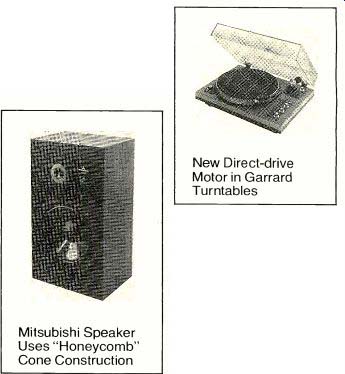
Mitsubishi Speaker Uses "Honeycomb" Cone Construction
The Mitsubishi MS-20 is a two-way acoustic-suspension loudspeaker whose bass-driver cone is a honeycomb structure of hexagonal aluminum cells sandwiched between two layers of glass-fiber-reinforced plastic. The ad vantages of this approach, according to Mitsubishi, include a high stiffness-to-weight ratio and substantially reduced harmonic distortion. Diameter of the MS-20's bass driver is 12 inches; that of its cone-type treble unit is 2 inches. The crossover between them takes place at 1,500 Hz. Nominal impedance of the system is 6 ohms; impedance is 3 ohms at 2,000 Hz. Frequency response is rated as 35 to 20,000 Hz ±-4 dB, power-handling capacity (measured using IEC methods) is 120 watts, and sensitivity is 88 dB output for a 1-watt in put as measured at a 1-meter distance. The enclosure of the MS-20 is finished in walnut.
An "edgeless" style of construction is used in conjunction with flush mounting of the drive units to reduce unwanted diffraction effects. A four-position rotary tweeter-level control is also flush mounted on the front panel. Dimensions are 24 3/4 x 14 3/4 x 11 7/8 inches. Price:
New Direct-drive Motor in Garrard Turntables
Garrard has introduced two turntables, the DD131 and DD132 (shown), with a newly de signed direct-drive motor that is said to be free of "cogging" (moving in subtly discrete rotational increments). The motor is slotless, brushless, and coreless, permitting the force that controls its rotation to be applied evenly throughout each revolution. Speed is con trolled by a servo system that operates by what Garrard calls "Time Integral Velocity" monitored by a Hall-effect control circuit.
Both new turntables share the same tone-arm design. The arm has a 9 1/4-inch effective length, an S-shaped aluminum shaft, and a magnesium head shell; total effective mass is 12 grams. The tone-arm system has jeweled bearings. The DD131 and DD132 have rumble specifications of-70 dB (DIN-B weighting), and wow and flutter is 0.06 percent or less.
Both have Garrard's "Delglide" cycling mechanism, which makes extensive use of low-friction synthetic materials, and both are single-play units, the difference being that the DD131 is semi-automatic and the DD132 fully automatic. Dimensions for both are 17 3/4 x 5 5/8 x 13 3/4 inches including base and with dust cover in place. Prices: DDI31, $189.95; DD132, $200.
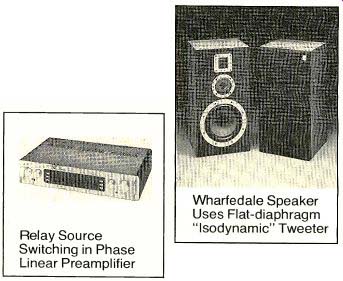
A Source for Budget Audio Gear
The Electronic Supermarket specializes in overruns and closeouts of electronic products, including amplifiers, completed and kit speakers, cabinets, and video equipment. A catalog is available for $1. Write to the Electronic Supermarket, Dept. SR, P.O. Box 619, Lynnfield, Mass. 01940.
Akai's Full Line Is Described in Latest Catalog
Akai has published a fifty-six-page pocket size catalog containing descriptions, selected specifications, and color photos of every product in the Akai audio-component line, plus a brief glossary of hi-fi terms. The catalog includes a reader-inquiry card by means of which consumers may send for more detailed information about particular products. For a copy of the catalog, write to Catalog, Akai America, Ltd., Dept. SR, P.O. Box 6010, Compton, Calif. 90224.
Relay Source Switching in Phase Linear Preamplifier
Phase Linear's Model 3000 preamplifier uses logic circuits and thirteen relays to select input sources, thereby avoiding routing pho no-level signals through a longer signal path than necessary.
Total harmonic distortion is rated at less than 0.04 percent. The rated signal-to-noise ratio is greater than 90 dB for the moving-magnet phono input, greater than 78 dB for the moving-coil phono input, and greater than 91 dB for high-level inputs. The input capacitance of the moving-magnet phono stage can be switched to 150, 225, or 420 picofarads, and the input resistance of the moving-coil in put to 50, 200, or 500 ohms. The phono stages adhere to the RIAA curve within 0.3 dB. The moving-magnet phono stage accepts an input of up to 120 millivolts, the moving-coil phono stage up to 12 millivolts.
The Model 3000 has two defeatable tone controls, each of which has two switch-select able turnover points: bass-control turnover points are 50 or 150 Hz and the treble control's are 2,000 or 5,000 Hz. The preamplifier also has a switchable low-frequency filter that attenuates at the rate of 18 dB per octave be low 15 Hz. A headphone amplifier with a 200 milliwatt output and total harmonic distortion below 0.07 percent is incorporated in the preamplifier; provisions for two tape recorders (with dubbing capability), a muting switch, and a detented volume control are also included. Dimensions are 19 x 31/2 x 8 inches. Price: $499.
Wharfedale Speaker Uses Flat-diaphragm "Isodynamic" Tweeter
The Wharfedale L300 loudspeaker system has a tweeter that consists of a flat sheet of plastic film (on which a voice coil has been printed) suspended between two panels of rare-earth magnets. The design, which Wharfedale calls an "Isotweeter," is said to have very low mass and high power-handling capability because of the unusual voice-coil construction, which drives the diaphragm uniformly over most of its surface. The L300 is a three-way, acoustic-suspension system with a 10-inch roll-surround bass driver, a 4-inch plastic-diaphragm mid-range unit, and the Isodynamic tweeter. Crossover frequencies are 1,000 and 5,500 Hz. Frequency response of the L300 is 38 to 26,000 Hz ±3 dB, nominal impedance is 6 ohms, and sensitivity for a 1-watt input is 88 dB measured at a 1-meter distance. Peak power-handling capacity of the L-300 is 90 watts. The enclosure is finished in walnut veneer and has dimensions of approximately 23 x 13 3/4 x 13 3/4 inches. Price: $275.
NOTICE: All product descriptions and specifications quoted in these columns are based on materials sup plied by the manufacturer. Recent fluctuations in the value of the dollar will have an effect on the price of merchandise imported into this country. Please be aware that the prices quoted in this issue may be subject to change.
Also see:
AUDIO BASICS: From Infrasonic to Ultrasonic.
THE PASSIONATE COLLECTOR: Do people really bankrupt themselves to buy a rare disc? PAUL KRESH
Source: Stereo Review (USA magazine)